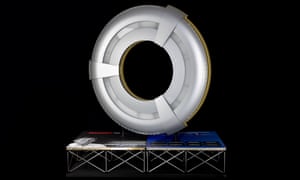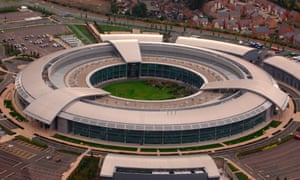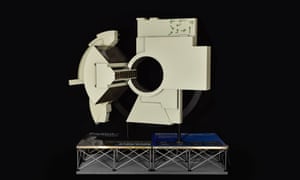Whenever I draw a circle, I immediately want to step out of it,” Buckminster Fuller once said. Unfortunately, the public thought the same when the architect tried to flog them his circular houses. But if we’re not living in circles in the 21st-century, we’re increasingly finding ourselves working in them. The circle is emerging as a key modern form for office buildings and a way of organising people. Stepping out of them may no longer even be an option.
Three sculptures in a new show at the Serpentine Gallery bring this looping train of thought to mind. They’re not really sculptures, more architectural models of the headquarters of three institutions: the Government Communications Headquarters (GCHQ) in Cheltenham, funky online retailer Zappos in Las Vegas, and Apple’s new campus, currently under construction in California. Each model has been tipped on its side, to accentuate the fact they are all circular.
This is more than just a coincidence. The models are by Simon Denny, a New Zealand artist who tackles the culture, impact and jargon of new technology. Previously, he’s made works that honour the tech maverick Kim Dotcom and mock the garish graphics of the National Security Agency’s (NSA) internal communications, as revealed by the Snowden leaks.
Now, Denny is scrutinising how similar hacking culture is to “contemporary radical management practices”. Chief among them is “holacracy”, or rather, Holacracy® – a public idea that’s also a privately owned concept, which is about right for this strange new world.
For those not up on their radical management slang, Holacracy is a “complete system for self-organisation” that replaces traditional hierarchies with a supposedly more efficient system of autonomous teams of employees called “circles”. “More like a city and less like a top-down bureaucratic organisation,” is how Zappos chief Tony Hsieh put it earlier this year. (Though he’s still the boss, so it’s not entirely un-hierarchical.)
Zappos, now owned by Amazon, is the biggest company so far to adopt Holacracy. It abolished all job titles and managers in late 2014, just as it moved into its new HQ, formerly Las Vegas City Hall. Zappos is the epitome of the trendy tech startup made good. Its motto is “deliver WOW through service”. It talks of its workforce in terms of “community” and “family”. And its circular campus is like a management diagram writ large.
Over at Apple, it’s a similar story. Their new campus, designed by Norman Foster and due to finish next year, is an elevated, four-storey, minimalist ring, utterly of a piece with Apple’s sleek products. Apple has not explicitly adopted Holacracy, but its innovation-seeking methodology has much in common with it. “The concept of the building is collaboration and fluidity,” an Apple exec told local planners. “We wanted this to be a walkable building – that’s why we eventually settled on a circle.”
Against all expectations, GCHQ is also flirting with Holacracy. It even won a business award last year for “creating the right environment for innovation and collaboration” (even if the creators themselves could not be identified). Former hackers as well as government suits roam the curved corridors of “the Doughnut”, as GCHQ’s base is known. This is not unusual, shows Denny. Big organisations are increasingly adopting the techniques of hackers, such as “hackathons”, where employees are encouraged to be playful, creative, even subversive. “Today, commercial organisations and hacking groups deploy a mixture of top-down and bottom-up techniques: a tension designed to enable directed, effective activity and also maintain the messiness necessary for the next thing to emerge,” he says.
Top-down and grassroots, private and public, secrecy and transparency, democratic freedom and Orwellian control – Denny’s work warns us that the boundaries are no longer visible.
All of this might sound eerily familiar to readers of Dave Eggers’ 2013 novel The Circle. The story takes place at a fictional boundary pushing West Coast social media outfit – a walled garden of cutting-edge tech, employee benefits and great parties. But those high principles of “transparency” and “openness” start to get sinister, to the point where workers are endorsing Animal Farm-style slogans such as “privacy is theft” and “secrets are lies”. Eggers never really describes the architecture of The Circle, only hinting at “brushed steel and glass” and a vast, rambling campus where “the smallest detail had been carefully considered”.
Architecture has always reflected its creators’ power structures, though for most of western history it’s taken a more classical form. See Giuseppe Terragni’s rigorously ordered 1930s Casa Del Fascio, commissioned by Mussolini as the National Fascist Party headquarters – a perfect half-cube. Or Terry Farrell’s monolithic MI6 building in London (the one James Bond’s enemies seem to love blowing up). But Dutch architect Rem Koolhaas was one of the first to apply this new circular logic – to the HQ of CCTV, the Chinese state broadcaster. Rather than a skyscraper, he folded the building back in on itself to create a gigantic loop, in the name of operational efficiency.
That’s not to say that all circular buildings represent some emergent 21st-century order. It is interesting, though, that past precedents have usually been buildings designed for spectatorship: sports stadiums or, more resonantly, panopticon prisons, where inmates’ cells are arranged in a ring so they’re visible to guards in a central observation tower. Take away that tower and you have the Apple campus.
“Art does not reproduce the visible; rather, it makes visible,” Paul Klee once said. For many artists today, surveillance has become central to that mission. As well as Denny you could include those who are turning surveillance infrastructure against itself, such as Jill Magid, who co-opted Liverpool’s citywide CCTV network for her art, and James Coupe, whose video installation Swarm used surveillance algorithms to “profile” gallery visitors, then composite them into demographically similar groups. Or Mishka Henner, who creates aerial images of sites like US military bases using Google Earth.
But perhaps the leader in this field is Trevor Paglen, best known for his ultra-long-range pictures of “secret” US military sites (as featured in Laura Poitras’s Edward Snowden documentary Citizenfour). Paglen has also shot spy satellites in the night sky, projected absurd NSA and GCHQ codenames on public buildings, and photographed idyllic locations, including a deserted Long Island beach, that conceal major internet and surveillance infrastructure. “I try to learn how to change my own vision,” he says, “so that when I walk around every day, I can see the fact that this is happening – because these are often abstract things – then try to show people how to see them.”
Paglen also made a short film on a surveillance flight around GCHQ’s “Doughnut”, which played before Citizenfour in cinemas last year. Its name – what else? – is Circles.





Aucun commentaire:
Enregistrer un commentaire